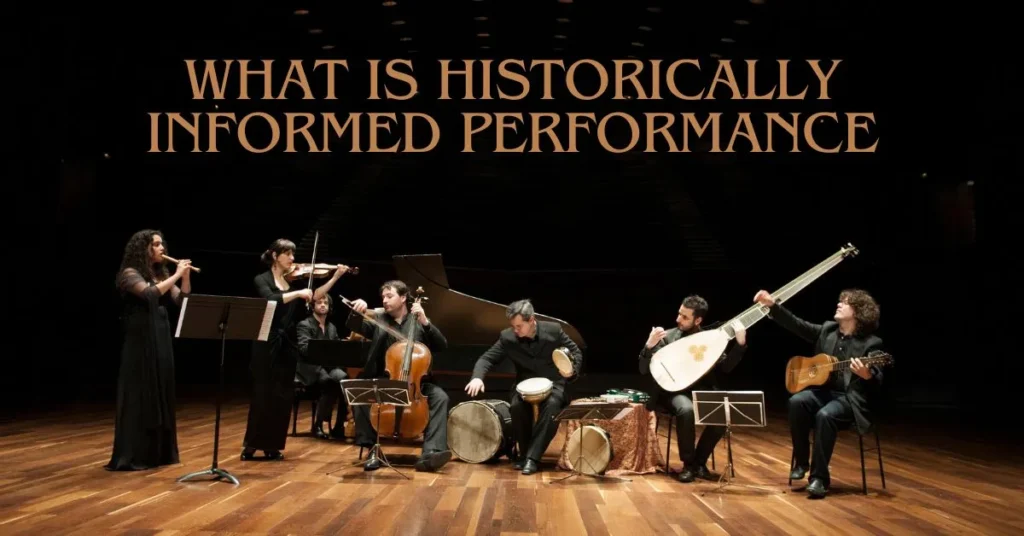Music lovers and performers often seek to connect with the past in authentic ways. This quest has led to a fascinating approach called historically informed performance. But what is historically informed performance, and why does it matter? Let’s explore this captivating world where history and music converge to bring old masterpieces to life in the most authentic way possible.
Understanding Historically Informed Performance:
Historically informed performance (HIP) is a practice in the world of classical music that aims to perform pieces as closely as possible to how they would have sounded when they were originally composed. This involves a deep dive into historical research, studying old instruments, performance techniques, and the context in which the music was created.
By understanding the instruments, tuning systems, and playing styles of the past, musicians strive to recreate the original sound of a piece. This approach isn’t just about mimicking the past but about understanding and conveying the composer’s intentions more accurately.
The Roots of Historically Informed Performance:
The origins of historically informed performance’s can be traced back to the early 20th century. Musicians and scholars began to question modern interpretations of old music, realizing that many elements had changed over the centuries. The movement gained momentum in the 1950s and 60s with the rise of early music ensembles dedicated to reviving Renaissance and Baroque music using period instruments.
One of the pivotal figures in this movement was Arnold Dolmetsch, who in the early 1900s, advocated for the use of historical instruments and techniques. His work laid the groundwork for future generations of musicians and scholars dedicated to historically informed performance.
Instruments and Techniques in Historically Informed Performance:
A key aspect of HIP involves using period instruments or replicas of them. These instruments often have a different sound quality compared to their modern counterparts. For instance, Baroque violins use gut strings instead of the steel strings found on modern violins, producing a warmer, softer sound.
Additionally, techniques such as bowing and fingering differ significantly from modern practices. For example, Baroque musicians would often employ a lighter, more articulated bowing style. Understanding these techniques is crucial for performers aiming to deliver an authentic interpretation of historical works.
The Role of Research in Historically Informed Performance:
Research is the backbone of historically informed performance’s. Musicians and scholars delve into a variety of sources, including original manuscripts, treatises, and historical accounts to gather information about how music was performed in the past.
This research helps performers understand the nuances of a piece, from ornamentation and phrasing to tempo and dynamics. By incorporating these elements into their performances, musicians can offer a more faithful rendition of the music.
Benefits of Historically Informed Performance:
So, why go through all this effort? What makes historically informed performance so valuable?
Authenticity and Integrity:
For many musicians, HIP is about honoring the composer’s original vision. By adhering to historical practices, performers can achieve a level of authenticity and integrity that brings them closer to the music as it was originally intended.
Fresh Perspectives:
Interestingly, historically informed performance can offer fresh perspectives on well-known pieces. Hearing a familiar work played on period instruments with historically accurate techniques can be a revelation, providing new insights and a deeper appreciation of the music.
Educational Value:
Historically informed performance’s also has significant educational value. It encourages musicians to engage deeply with music history, fostering a greater understanding of the cultural and historical context of the pieces they perform.
Common Misconceptions about Historically Informed Performance:
Despite its growing popularity, HIP is sometimes misunderstood. Let’s clear up a few common misconceptions.
It’s Only for Early Music:
While historically informed performance’s is often associated with Renaissance and Baroque music, it’s not limited to these periods. HIP principles can be applied to music from any era, including Classical, Romantic, and even early 20th-century works.
It’s About Imitation:
HIP isn’t about rigidly imitating the past. Instead, it’s about informed interpretation. Musicians use historical knowledge as a foundation but still bring their own artistic sensibilities to the performance.
It’s Restrictive:
Some might think that HIP is restrictive, limiting creativity. In reality, it opens up new avenues for expression. By understanding historical practices, musicians can make more informed and nuanced artistic choices.
How Historically Informed Performance Influences Modern Music?
The impact of historically informed performance’s extends beyond classical music. Modern musicians and composers often draw inspiration from HIP practices, incorporating elements of historical techniques and instruments into their work.
For example, contemporary ensembles might use period instruments to add unique textures and colors to their music. Composers might study historical forms and styles to inform their own compositions, blending old and new in innovative ways.
The Future of Historically Informed Performance:
As interest in historically informed performance continues to grow, its future looks bright. Advances in research and technology are making it easier than ever for musicians to access historical information and resources.
Expanding Repertoire:
As HIP principles are applied to a broader range of music, we can expect to see a more diverse repertoire being performed. This includes not only lesser-known works from the past but also new compositions inspired by historical practices.
Increasing Accessibility:
Technology is also playing a role in making historically informed performance more accessible. Online archives, digital manuscripts, and virtual masterclasses are providing musicians around the world with the tools they need to explore HIP.
Collaboration and Innovation:
The future of HIP will likely involve greater collaboration between musicians, scholars, and instrument makers. This collaborative approach will continue to push the boundaries of what is possible, blending historical accuracy with modern creativity.
Getting Started with Historically Informed Performance’s:
If you’re a musician interested in exploring historically informed performance, where should you start?
Study Historical Sources:
Begin by studying historical sources such as treatises, manuscripts, and recordings of performances by renowned HIP musicians. These resources can provide valuable insights into historical techniques and practices.
Experiment with Period Instruments:
If possible, try playing period instruments or modern replicas. This hands-on experience can help you understand the unique qualities of these instruments and how they influence performance.
Seek Guidance:
Consider taking lessons or attending workshops with experienced HIP practitioners. Their expertise can guide you in developing your own historically informed interpretations.
Conclusion:
Historically informed performance’s is a fascinating and rewarding approach to music-making. By delving into the past and understanding the context in which music was created, musicians can bring a new level of authenticity and depth to their performances. Whether you’re a performer or an avid listener, exploring what is historically informed performance’s can enrich your appreciation of music and its history. So, why not take a step back in time and discover the timeless beauty of historically informed performance?







